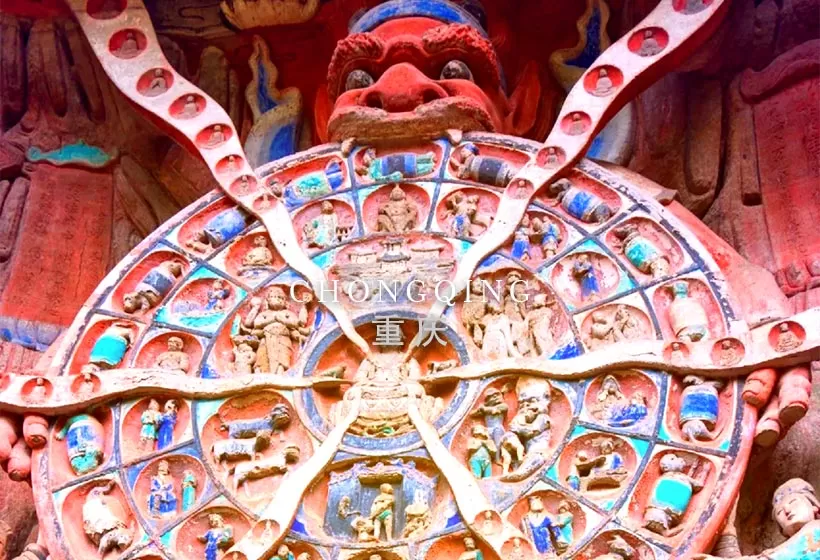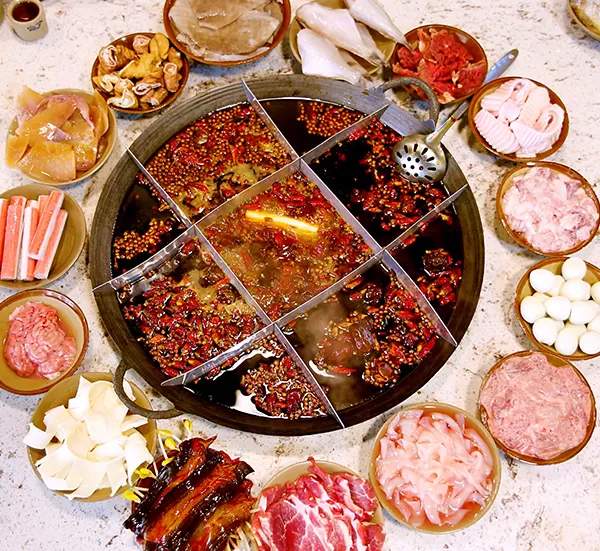Top 10 Best Things to Do in Chongqing: Strolling, Eating, Cruising...
Xining is far more than just a fleeting stop on your journey. This gem of the plateau holds countless reasons for you to linger. From bustling commercial districts to natural wonders, from historical relics to authentic local cuisine, Xining awaits your careful exploration and savoring. Following are the best things to do in Xining.
Top 1: Stroll among the Mountain City
Chongqing is surrounded by mountains and built down their slopes, creating its signature surreal style where "the mountain is the city, and the city is the mountain". With its undulating terrain, winding rivers, and a dense network of bridges, Chongqing has earned the nickname "8D Magic City" for its dizzying, layered urban landscape.
The city's mind-bending transportation is the existence that even makes GPS navigation systems afraid. A maze of roads crisscrosses the city, with intricate and spiraling overpasses perfectly embodying the city's tridimensional character. Strolling through this towering steel forest of prosperity means endless stairways and countless overpasses, in which every path reveals a different urban vista.
By day in Chongqing, every unassuming old alley seems to conceal a tale of warmth and nostalgia. A stroll through these streets inevitably conjures scenes straight from an old film. Wandering the narrow lanes, one leave behind the clamor of the modern world and slip unknowingly into the 1980s. Dilapidated apartment buildings nestled beneath lush trees feel full of traces of time. At sunset, when golden light washes over the old streets, every corner exudes a quietly romantic glow.
Hongya Cave sets along a cliff, forming a unique "three-dimensional skywalk street" in Chongqing. From afar, the ancient-style buildings cascade one atop another, side by side with gleaming skyscrapers, evoking a sense of confusion through time and space.. When night falls and the lights flicker on, Hongya Cave transforms into a celestial palace, with its over-thousand-meter stretch of stilted houses illuminated in soft, warm light. Strolling through it, the shimmering traditional architecture reflected in the waters of the Jialing River feels like a scene lifted straight out of Spirited Away, where every snapshot a postcard-worthy scene.
Top 2: Eat Authentic Chongqing Hotpot
Chongqing's local character and human touch are truly one of a kind. The people here are passionate, bold, and refreshingly direct, much like the city's famous hotpot: fiery, intense, and full of flavor. As you wander through the bustling streets and narrow alleys of Chongqing, you can't help but be swept up by the infectious warmth of its people, alive with constant chatter and peals of laughter. Chongqing hotpot is undoubtedly the most superexcellent representative of Chongqing's cultural customs.
An authentic Chongqing hotpot begins with a ladleful of scalding hot oil. As it's poured over the spicy base, the entire pot erupts into boil, releasing a rich, heady aroma of chili and spices. In that instant, the fragrance assaults the senses, awakening appetites and teasing taste buds, making it impossible to wait for the feast to begin. For those who can't handle spice or have a sensitive stomach, you can opt for the double-flavor hotpot. While you might miss out on the authentic experience, the clear broth offers its own delightful flavors, and when paired with dipping sauces, it still promises an equally delicious feast.
The moment the first morsel of food is dipped into the boiling broth and lifted to your lips, the burst of freshness and rich flavor hits your palate, followed closely by a surging wave of spiciness and numbing heat. The spice is intense but not overpowering, and the numb is thrilling without bitterness. The two harmoniously entwine, igniting every taste bud and delivering an exhilarating, unforgettable experience. Within this interplay of spice and fresh, one can almost taste the enthusiasm and vigor of Chongqing. Whether gathered with family or meeting with friends, Chongqing hotpot turns every dining into a cherished, memorable moment.
Top 3: Take the Chongqing Rail Train
The Chongqing Rail Transit serve not only as a practical means of transportation for the city's residents but also as creators of surreal, cinematic cityscapes. One moment, the trains dive 60 meters underground; the next, they curve gracefully through mountain tunnels and across bridges in elegant S-shaped routes, leaving behind its fleeting figure. In the "8D Magic City", architects and urban planners have masterfully harnessed the mountainous terrain, seamlessly integrating transportation and residential projects to create routes that soar into the sky and cling to the cliffs.
Among them, the world-renowned Liziba Station is no ordinary stop. Liziba Station is the country's first elevated light rail stop that coexists with a residential tower, where the track passes cleanly through the 6th to 8th floors of the building. Residents live undisturbed above, while trains rumble quietly through below, both worlds operating in harmony.
As the tarin snakes along the mountainside, it navigates hairpin turns at nearly 90 degrees. Riding it feels like a roller coaster adventure, showcasing Chongqing's uniquely thrilling transit charm. It winds its way along the river, stringing together the city's many sights. Ancient towns, lush parks, towering skyscrapers, and sprawling bridges all flickering past in rapid succession, with the landscape constantly in motion leaving travelers reluctant to leave.
Top 4: Soak in a Chongqing Hot Spring
As the World Capital of Hot Springs, Chongqing lives up to its reputation with a saying: "There's hot water in every mountain, and hot springs in every gorge." Thanks to its distinctive mountainous terrain and abundant water sources, Chongqing's hot springs are naturally extraordinary. How did they come to be? No special method, no deliberate technique, only nature's generous favor, that call "Somebody up there loves Chongqing".
Situated on the eastern Sichuan fold belt, Chongqing boasts rock strata rich in fissures, with abundant geothermal resources feeding its numerous hot springs. The city's hot spring area spans over 10,000 square kilometers, with a staggering 1.21 million tons of hot spring water ready to be tapped every day. The number of identified hot spring sites continues to grow year after year. In fact, beneath the feet of people walking through the city streets, at least 100,000 cubic meters of hot spring water flows daily.
Among Chongqing's many hot springs, the most renowned are the four great springs of the east, south, west, and north, collectively known alongside Tongjing Hot Spring as the "Old Five Springs". Leading them is the famous North Hot Spring, shrouded in mist and steam, where 26 uniquely styled pools nestle amid lush forests. Soaking in the warm waters, one can feel the heat coursing through one's body while the gentle flow of the Jialing River and the verdant gorges beyond meet your gaze, refreshing both body and soul. Walking along stone paths, surrounded by a natural mountain and forest screen, one enjoys the purest form of closeness with nature.
Top 5: Cruise among Small Three Gorge
About 400 kilometers east of Chongqing lies Wushan County, often referred to as "Little Chongqing". Here, visitors can board a cruise to explore the magnificent cliffs and emerald-green scenery of the Wushan Small Three Gorges and its sister gorges, the Mini Small Three Gorges.
Starting from the Wushan Tourist Center, the cruise sets sail into the "world wonder", the Small Three Gorges, around four hours. As people ride in boats and the boats glide between towering cliffs, the scenery on both sides dazzles like embroidered brocade, awash in vibrant hues. Passengers can fully experience the grandeur of Longmen Gorge, the strangeness of Bawu Gorge, and the secludedness of Dicui Gorge.
Towering rugged peaks, ever-changing misty clouds, secluded cascading waterfalls, enigmatic cliff caves, and lush thriving forests of pine and bamboo, form an exquisitely crafted natural potted plant. Monkeys leaping through treetops, waterbirds taking flight spreading wings, fish gliding through emerald waters, and the chorus of birdsong filling the groves, create a veritable wildlife paradise. The millennia-old mysteries of Ba people's hanging coffins, boat-shaped burial relics, and ancient mountain fortresses, stand as precious historical relics. This extraordinary canyon scenery, where natural landscapes and cultural heritage blend seamlessly, shines as an eternally radiant jewel along the golden tourism route of the Yangtze Three Gorges.
Top 6: Take the Yangtze River Cableway
Chongqing is a renowned mountain-and-water city, where the Bashan Mountains stretch endlessly and rivers weave through the land. In places where no roads once existed, the people of Chongqing carved out their own unique paths, building river cableways, mountain elevators and hillside escalators. Rising to the skies, plunging underground, tunneling through mountains, and crossing over rivers, it is not only the result of Chongqing's dramatic geography but also a testament to the resilient and indomitable spirit of its people.
The beauty of Chongqing lies in its distinctive form. The city is built against mountains and stands by rivers. One of the best ways to experience Chongqing's unique charm is by taking the Yangtze River Cableway. From high above, the stunning panorama of mountains, rivers, and cityscapes unfolds beneath your feet. The distant mountain ranges, riverfront skyline, majestic bridges, and shimmering waters stack one upon another like scenes from a 3D urban epic. Gliding between skyscrapers and soaring over vast rivers, you can truly savor the magnificence of this city where mountains and waters merge. It's no wonder there's a popular saying: "See the mountain city by day, gaze at a sea of lights by night; if you haven't taken the cableway, you haven't truly been to Chongqing."
Top 7: Enjoy the Chaotianmen Night View
Chaotianmen is located at the confluence of the Yangtze River and the Jialing River, which serves as the departure point for Three Gorges cruises, sightseeing boats, and ferries heading to Foreigner Street. The history of Chaotianmen can be traced back to the Qin Dynasty in 314 BC. Every early summer and mid-autumn, when the waters of the Jialing River turn green and the Yangtze River runs yellow, the two colors collide and merge at Chaotianmen, weaving a strikingly unique spectacle.
As Chongqing's largest water transport wharf, Chaotianmen Wharf has always been a bustling hub. From ancient times to today, it has remained lively and crowded. Standing atop a high-rise building, one can take in the magnificent view of the Yuzhong Peninsula. At night, the mountain city glows, with dazzling lights from the bustling business district at the heart, interconnected by illuminated main roads and bridges, and a sea of residential lights as the backdrop, together forming a layered, orderly, and beautifully staggered "ocean of lights". Lights from the city blink, boat lights dance upon the rivers, and the brilliance reflects in the shimmering waves, merging seamlessly with the twinkling stars above. The scene bursts with color, like a dreamlike world out of a poem or song, breathtakingly beautiful and endlessly enchanting.
Top 8: Take the Crown Grand Escalator
Crown Grand Escalator, located in Chongqing's Yuzhong District, serves as an important link between Lianglukou and Caiyuanba stations, one of Chongqing's uniquely characteristic modes of transportation. Stretching 112 meters in length, rising 52.7 meters in height, and sloping at a 30-degree angle, it takes 2 minutes and 30 seconds to complete a ride — making it the longest sloped escalator in China and the second longest in Asia, often hailed as "China's No.1 Mountain-Climbing Escalator".
Before the Crown Grand Escalator was built, the primary connection between Lianglukou and Caiyuanba was the Lianglukou cable car. With the completion of the escalator, the cable car gradually faded into history, but its legacy continues in a new form through the escalator. The Crown Grand Escalator isn't just a practical transportation facility, but also has become a symbol of Chongqing's "magical realism".
Many visitors come to Chongqing driven by curiosity about this remarkable escalator, eager to experience its one-of-a-kind ride. While ascending, it feels like soaring in the air through the mountain city, creating a striking visual impact and a uniquely addictive sensation that leaves a lasting impression.
Top 9: Explore in the Wulong Tiankeng
Wulong Tiankeng, also known as Wulong Three Natural Bridges, is famed for its grand and awe-inspiring naturally formed stone arch bridges, consists of Tianlong Bridge, Qinglong Bridge, and Heilong Bridge. Between the three massive natural arches lie two giant sinkholes, together forming a rare and spectacular geological wonder known as the "Three Bridges with Two Sinkholes".
Visitors take an 80-meter-deep sightseeing elevator straight down to the bottom of the sinkhole. The first bridge to appear is Tianlong Bridge, which from a distance resembles a soaring dragon in the sky. Beneath it is the entrance to Qinglong Tiankeng, a vast sinkhole over 200 meters deep, its cliffs enclosing a traditional courtyard-style inn named Tianfu Posthouse, which also served as a filming location for Transformers: Age of Extinction. Following a quiet stone-paved path leads to Qinglong Bridge, the most majestic and perilous of the three. At sunset, with the shifting glow of twilight, it appears like a dragon ascending to the heavens. The bridge, together with the surrounding cliffs, forms a square-shaped sinkhole known as the "Shenying Tiankeng" (Divine Eagle Sinkhole), so named because the cliff edges resemble a great eagle about to take flight. At the far end lies Heilong Bridge, whose dark, narrow arch casts a shade within, like a black dragon coiled beneath the ceiling of the cave, featuring its unique four springs.
Yet Wulong's karst landscape holds far more than just these sinkholes. Furong Cave, Fairy Mountain, and Longshui Gorge, each awaits curious adventurers to explore.
Top 10: Enjoy the Snow in Fairy Mountain
When winter arrives, Fairy Mountain lives up to expectations, ushering a magnificent snowy spectacle. The snow falls in swirling flurries, draping the entire Fairy Mountain in a silvery-white mantle. The wilderness and forests are blanketed in timely snow, vast and holy. while shimmering rime and ice cascades stir the heart.
Hop aboard a bright red little train as it weaves through a vast sea of white forests, gliding along rolling, picturesque roads. Amidst Fairy Mountain's icy wonderland, let your mind quiet and soak in the aesthetic of the snow. Wander along forest trails until a boundless snowfield opens up. Strolling across the snow, every crunch beneath your feet leaves a trail of footprints that belong to you alone. Step into the snowy woods, get up close to the frost-covered branches, and capture your most stunning winter photos. At the ski resort, embrace the thrill and exhilaration of speeding down the slopes, savoring the joys of snow sports. Out on the sprawling snowfields, build snowmen, engage in playful snowball fights, and rediscover the carefree, childlike joy.
GREAT FAMILY CHINA TOUR
JULY 2024 We wanted to thank Grace at China Culture tour for organizing a great tour of China. We enjoyed our Beijing - Xian-Chengdu -Guilin -Yangshuo - Shanghai trip. Our local guides Bruce in Beijing, Susan in Xian, Jane in Chengdu, Mike in Guilin and Mary in Shanghai took care of us…read more details »
Teng Han L from SINGAPORE
Ready to Create a Unique Dream Travel?


